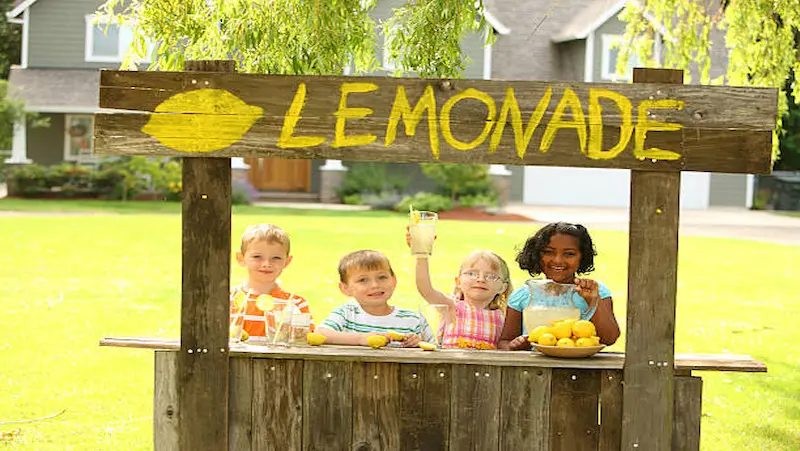In the dynamic world we live in, financial literacy stands as a crucial life skill, especially for middle school students who are beginning to navigate the realms of independence and responsibility. Much like learning to ride a bike or mastering a new subject, understanding the basics of money empowers young minds to make informed decisions about their financial future. It’s not just about dollars and cents; it’s about laying the groundwork for a secure and confident journey into adulthood. In a world where financial choices are abundant, arming fun money activities for middle school students is akin to handing them a compass for a successful journey ahead.
Table of contents
- Money Scavenger Hunt
- Stock Market Simulation Game
- Entrepreneurial Lemonade Stand
- Budgeting for a Dream Vacation
- Design Your Own Currency
- Financial Literacy Board Game
- Charity Fundraising Project
- Virtual Stock Market Challenge
- DIY Piggy Bank Workshop
- Financial Literacy Jeopardy
- Conclusion:
- Frequently Asked Questions
Money Scavenger Hunt
Money lessons can be a bit dry, but who said learning about currency and denominations can’t be a thrilling adventure? Enter the Money Scavenger Hunt – an interactive and exciting way to make those financial concepts stick!

Unleashing the Excitement
Imagine the joy on your child’s face as they embark on a treasure hunt, with dollar bills and coins as their compass. The Money Scavenger Hunt transforms learning into an engaging experience, making those lessons on dollars and cents memorable and, dare we say, fun!
Crafting Clues with Financial Flair
Creating clues that spark financial curiosity doesn’t have to be rocket science. Start with simple concepts and build from there. For example, hide a clue near the piggy bank to teach the importance of saving. Use riddles like, “Where does money sleep at night?” to lead them to their bed – and their next clue!
Tip 1: Think Everyday Situations
Integrate lesson plans on money seamlessly into everyday scenarios. For instance, if you’re hiding a clue in the kitchen, use a clue like, “Find the place where we plan our weekly meals.” This not only sharpens their financial skills but also encourages them to connect learning to real-life situations.
Tip 2: Mix Mystery with Math
Keep the challenge alive by incorporating a bit of math. Create clues that involve counting coins or determining the value of a set of bills. Sneak in a math lesson without them realizing it – the best kind of learning!
Tip 3: Reward the Discoverer
Every treasure hunt deserves a prize! Consider offering a small reward or treat at the end of the scavenger hunt. It could be a little extra pocket money or a special treat they’ve been eyeing. This not only adds excitement to the quest but also reinforces the positive association with learning about money.
Stock Market Simulation Game

Getting Started
Imagine a game that lets you step into the shoes of a stock trader without the real-world risks. It’s like playing a video game, but instead of navigating through dungeons, you’re navigating through the stock market.
The Basics of the Stock Market
Now, don’t worry if words like “stocks” and “trading” sound like a foreign language. The stock market is essentially a giant marketplace where people buy and sell tiny pieces of big companies. These pieces are called stocks, and owning them means you own a small part of that company.
In our game, you get a virtual pile of money to spend on these stocks. Your goal? To make that money grow by buying low and selling high. It’s like buying a rare day trading card at a low price and selling it for a higher one—simple, right?
Playing in a Mock Trading Environment
Here’s the cool part: you won’t be playing with real money. Instead, you’ll use pretend money to make your investments. It’s like having Monopoly money, but instead of hotels on Boardwalk, you’ll be investing in companies like tech giants, sneaker moguls, or even pizza chains.
As the stock prices go up and down, so does your virtual wealth. It’s like a roller coaster of financial excitement without any of the real-world stomach flips.
Why it Matters
But why bother with all this stock market stuff? Well, besides being loads of fun, it teaches you important skills. You’ll learn about smart decision-making, patience, and how the business world works. Plus, it’s a glimpse into the grown-up world of finance.
Entrepreneurial Lemonade Stand
Ah, the sweet taste of entrepreneurship – and in this case, it’s lemonade! Starting a small business, like a lemonade stand, isn’t just about making money; it’s about learning the ropes of running your own show.

A Squeeze of Entrepreneurship
Imagine this: You set up a table, hang a cheerful sign, and suddenly you’re in business. A lemonade stand is like a tiny classroom where you’re the teacher and the student. You’ll be amazed at how much you can learn about money, responsibility, and, of course, making a killer lemonade.
Counting Lemons, Counting Money
Budgeting might sound like a grown-up thing, but not when it comes to lemonade stands. Think about what you need – lemons, sugar, cups, and maybe some cool shades to attract customers. Plan wisely, spend carefully, and keep an eye on those lemons turning into dollars.
Pricing – Not Too Tart, Not Too Sweet
Setting the right price is like finding the perfect balance of sweet and tangy in your lemonade. It’s not just about covering costs; it’s about making a profit too. Ask yourself, what would you pay for a cup of refreshing lemonade on a sunny day? That’s probably a good place to start.
Dollars and Sense – Calculating Profits
Okay, so you’ve got your stand, your lemonade is a hit, and the coins are piling up. Now what? It’s time to do some basic math. Subtract what you spent from what you earned, and voilà – you’ve got your profit. It’s like turning lemons into lemonade, but with a money twist.
Budgeting for a Dream Vacation

Introducing the Dream
Imagine sipping coconut water on a sandy beach or exploring city lights under the night sky. That’s your dream vacation, and guess what? It’s totally achievable with a sprinkle of smart money moves.
Cracking the Budget Code
Now, let’s get down to business—budgeting. It’s not as scary as it sounds; think of it as your financial GPS. First, list your dreamy expenses—flights, accommodation, those extra guacamole servings, you name it. Google is your friend here; get some ballpark figures.
Making the Money Dance
Once you’ve got your dream expenses lined up, let’s talk about the money dance. How much can you save each week or month? Be realistic, but also a bit ambitious. Maybe skip that extra frappe or save on movie nights. Trust me, your future self lounging on a beach will thank you.
Decisions, Decisions
It’s decision time! Can you find a more budget-friendly flight if you tweak your travel dates? Is there a cozy Airbnb that won’t drain your funds? Every penny saved is a step closer to that dream.
Design Your Own Currency

Embrace Your Inner Artist
Okay, so first things first: think about what makes your currency uniquely you. Is it a majestic unicorn, a super-powered robot, or maybe even a slice of pizza? It’s your world – your call!
The Nitty-Gritty of Design
Now, let’s talk shop. What colors represent your currency? What symbols scream ‘you’? Remember, it’s not just about looking cool; think about what your symbols stand for. Maybe it’s teamwork, adventure, or a love for tacos – you decide.
Denominations Galore
Time to play banker! What’s the value of your currency? Is there a one-pizza slice bill or a ten-unicorn coin? Assigning values is like giving your currency its superpowers.
Fort Knox Security
Nobody likes a fake currency, right? Add some security features – holograms, glitter, secret codes (or maybe just really good drawings) – whatever it takes to keep your money legit.
Why This Matters
Creating your currency isn’t just about fun (although it’s a blast!). It teaches us about value, creativity, and how to express ourselves. Plus, who knows, maybe one day you’ll see your currency in the wallets of millions (dream big!).
Financial Literacy Board Game

Crafting the Game: Unleash Your Inner Game Developer
Ever thought about making a game that’s not just fun but also teaches you the ropes of handling cash like a pro? Well, that’s exactly what we’re aiming for here. Imagine a game board filled with opportunities to earn, save, and invest – sounds cool, right?
Game Mechanics: Turning Money Lessons into Fun Moves
Now, let’s get down to business – literally. Your game should have some sweet mechanics that mirror real-life money situations. Think about spaces where you earn “payday” or face challenges that test your financial savvy. It’s like navigating through the game of life, but with a finance twist.
Rule of the Game: Making Money Moves
Every great game has rules, and yours will be no exception. Create simple and clear instructions that guide players through the world of income, expenses, and maybe even a little bit of risk-taking. The goal is not just to win but to learn a ton about money management along the way.
Why This Game Rocks: Financial Principles at Play
What’s super cool about your activities for financial literacy board game is that it’s not just for fun – it’s a learning experience. As you play, you’re picking up essential skills like budgeting, investing, and decision-making. It’s like stealth learning but with dice and game pieces.
Charity Fundraising Project

Let’s Talk Charity:
First things first, what’s a charity? It’s a way of helping others, lending a hand to those who might need it. A charity fundraiser is like throwing a party with a purpose—your goal is to collect money to support a cause you care about.
Getting Started:
Think about what causes pull at your heartstrings. Is it helping animals, supporting kids’ education, or maybe planting more trees? Once you’ve got your cause, it’s time to plan.
Planning Your Fundraiser:
Picture this: You’re organizing a bake sale, a car wash, or maybe even a talent show. Anything that people in your community would enjoy and be willing to support.
Budgeting Basics:
Now, we can’t dive into the fun stuff without talking about money. You’ll need to plan how much everything might cost—materials for your event, maybe some posters to spread the word, and don’t forget a little extra for unexpected surprises.
Setting Goals:
Goals are like the treasure map of your fundraising journey. How much money do you want to raise? Set a target that feels challenging but doable. It’s like aiming for the stars while keeping your feet on the ground.
Spreading the Word:
Get your friends, family, and community involved. Share your passion and why this cause matters. Social media, posters, or even good old-fashioned word of mouth—spread the word like confetti!
Track Your Progress:
As the donations start rolling in, keep track of how much you’ve collected. It’s like watching a scoreboard during a game. Celebrate small victories, and don’t forget to thank everyone who chips in!
Virtual Stock Market Challenge

Getting Real (but Not Too Real):
So, imagine a place where you can dip your toes into the stock market without risking your lunch money. That’s the magic of virtual stock market challenges! These are like video financial games for students, but instead of conquering kingdoms, you’re conquering the world of investments.
Meet Your Online Sidekick:
There are cool platforms out there that turn learning about stocks into a game. You sign up, get a virtual cash stash (no real money involved – phew!), and then it’s time to play Wall Street from your computer.
Why Virtual? Because Learning Should Be Fun:
Why go virtual, you ask? Well, it’s like practicing your soccer moves before hitting the field. Virtual stock market challenges let you make mistakes without the “uh-oh” of losing real money. You get to learn the ropes, experiment, and, most importantly, have fun while doing it!
Benefits Galore:
These challenges aren’t just about bragging rights. They’re like a secret weapon for learning. You get a taste of how the stock market rollercoaster feels without risking your allowance. Plus, you can learn from every up and down, turning you into a money-savvy ninja in no time.
DIY Piggy Bank Workshop

Get Crafty with Savings:
Imagine a world where your spare change transforms into something amazing—a piggy bank of your own creation! Gather your craft supplies, because it’s time to turn ordinary into extraordinary.
Why Piggy Banks?
Piggy banks aren’t just cute, they’re money-saving superheroes. They teach us the power of setting aside a little here and there. Plus, making your own? That’s like having a personal money mascot cheering you on.
Materials You’ll Need:
1. An empty container (old jars or boxes work like magic).
2. Paints, markers, stickers—let your creativity run wild!
3. Scissors and glue to add that extra flair.
4. Imagination—the secret ingredient.
Crafting Your Money Vault:
1. Choose Your Container: Find something that speaks to you. Maybe it’s a sturdy jar with memories or a box that’s ready for a makeover.
2. Decorate: This is where the magic happens! Paint it, color it, or stick it on glitter. Your piggy bank, your rules.
3. Name Your Piggy: Every piggy needs a name. Is it Penny the Posh Pig or Sammy the Saving Superstar? Let your imagination soar.
4. Make a Slot: Cut a small slot at the top for your coins and bills. Watch out, world—here comes your money.
The Money Talk:
As you craft, think about why you’re doing this. What’s your savings goal? Whether it’s for a dream toy or a future adventure, knowing why you’re saving makes it all the more exciting.
Financial Literacy Jeopardy

Learning Can Be a Game:
Who says learning about money has to be boring? Imagine a room full of excited kids, bursting with energy as they dive into a custom Jeopardy game designed just for them. It’s not just about answering questions—it’s about having fun while gaining valuable financial knowledge. This interactive approach makes financial education for kids exciting and memorable, turning essential lessons into an engaging and enjoyable experience.
Sample Questions to Get You Started:
Let’s get a taste of the action with some sample questions. Remember, the goal is to make learning entertaining:
Category: Budgeting
1. “I’m money you’ve set aside for emergencies. What am I?”
2. “Daily double! How can tracking your expenses help with budgeting?”
Category: Saving
1. “What’s the difference between ‘want’ and ‘need’ when it comes to saving?”
2. “How does compound interest make your money grow?”
Category: Investing
1. “Name one type of investment besides stocks and bonds.”
2. “True or false: Diversifying your investments reduces risk. Explain.”
Conclusion:
In wrapping up, it’s clear that integrating creative money extracurricular activities into the learning journey is a win-win for educators and parents alike. By making finances fun and engaging, we’re not just teaching kids about dollars and cents; we’re equipping them with essential life skills. So, let’s champion this approach, fostering a generation that not only knows the value of a dollar but also understands the importance of financial responsibility. It’s an investment in their future that pays dividends beyond the classroom.
To get your hands on more such articles, educational content, and free resources on coding for kids, robotics courses, game development, etc., check out the BrightCHAMPS Blog Page now!
Frequently Asked Questions
A1. Absolutely! One fun activity is the “Entrepreneurial Lemonade Stand.” It taps into their creativity, letting them run a small business while learning about budgeting and profits. Another is the “DIY Piggy Bank Workshop,” a hands-on craft that subtly introduces the concept of saving without feeling like a lecture.
A2. Sure thing! The “Virtual Stock Market Challenge” is an exciting online game where students can virtually invest and learn about the stock market. Also, “Financial Literacy Jeopardy” turns learning into a competitive and enjoyable experience, covering budgeting, saving, and investing topics.
A3. These activities blend fun with education by turning financial concepts into hands-on experiences. Whether running a lemonade stand or playing virtual stock market games, students learn key financial skills while enjoying interactive and entertaining challenges.
A4. Certainly! The “Design Your Own Currency” activity sparks creativity while subtly introducing elements of responsible money management through discussions about symbols, denominations, and security features.
A5. These activities provide real-world scenarios, fostering a practical understanding of money management. From budgeting for a dream vacation to virtually investing in stocks, students gain valuable insights into financial decision-making.


 We are an army of educators and passionate learners from BrightChamps family, committed to providing free learning resources to kids, parents & students.
We are an army of educators and passionate learners from BrightChamps family, committed to providing free learning resources to kids, parents & students.














